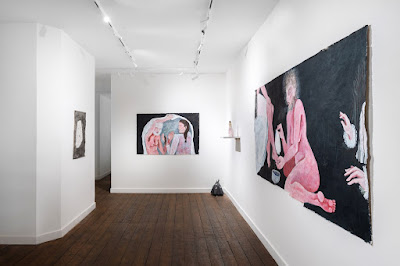Close - Drawn Portraits at The Drawing Room
As a uniquely public and not-for-profit space dedicated to contemporary drawing, the Drawing Room’s latest iteration in the south London pocket of Walworth is a bold one, not least because the area is hardly famed for its booming contemporary art scene, but also its warehouse-like interior is fairly inconspicuous. The calibre of artists in ‘Close: Drawn Portraits’ is incredibly high, and although the subject matter wouldn’t be my usual taste, Drawing Room has curated something to cater for all tastes and expectations in the realm of portraiture.
Drawn portraits might seem a little dry, but this isn’t a historical study, and the exhibition includes truly touching drawings, as well as portraits that really spring to life through colour and the respective artists’ unique technique.
Paula Rego, Self Portrait III, 2017. Pastel on paper, 59cm x 42cm. Image courtesy of the artist and Marlborough Fine Art, London.
Paula Rego’s five bold self portraits convey emotions that are so multifaceted that they draw the viewer in from across the room, presenting the type of portrait that is very contemporary and will appeal to younger audiences who may find traditional portraiture somewhat stale. The works showcase the artist’s struggling body, having been injured in an accident; the emotional and physical distress is vivid and terrifying, while remaining utterly beautiful. Virginia Chihota’s ink works bear a similarly striking effect; the densely deep black pigments leap out of the pure white of the paper and the plinth on which Chihota’s works stand, elevated from the despair evident in the work. Figures in the artist’s Untitled drawings are sat down with their legs uncomfortably straight in front of them, clawing at and covering their face. It is interesting to see how clichés of women emerge from portraits, like Chihota’s hysterical character, yet portraits of men tend to be conservative and professional.
Installation view: Close: Drawn Portraits at Drawing Room.
Image courtesy of Andy Keate.
Frances Picabia, Jeune espagnole, 1926. Pencil and watercolour on paper, 24cm x 18cm.
Private collection, image courtesy of Drawing Room.
Private collection, image courtesy of Drawing Room.
Boasting pioneering artists such as Cézanne, Picasso and Hepworth is a significant move not only for Drawing Room but for the contemporary artists within the show to shine in comparison; the differences make the exhibition incredibly well-rounded and more stimulating than showcasing one or the other. Frances Picabia's 'Jeune Espagnole (Young Spaniard)' from 1926 is stunning in its simplicity, and similarly the 'Portrait of the Princess Louise Murat' by Jean-Auguste-Dominique Ingres in 1814 is before its time with an impeccably detailed face followed by a shakily sketched body, and is ghostly in its form and lost stories. Like every personal portrait, the ghosts of the past live on through these drawings, and we find ourselves wondering about the unspoken tales of both sitter and artist, awakening our interest in a way that is surely unique to this art form.





